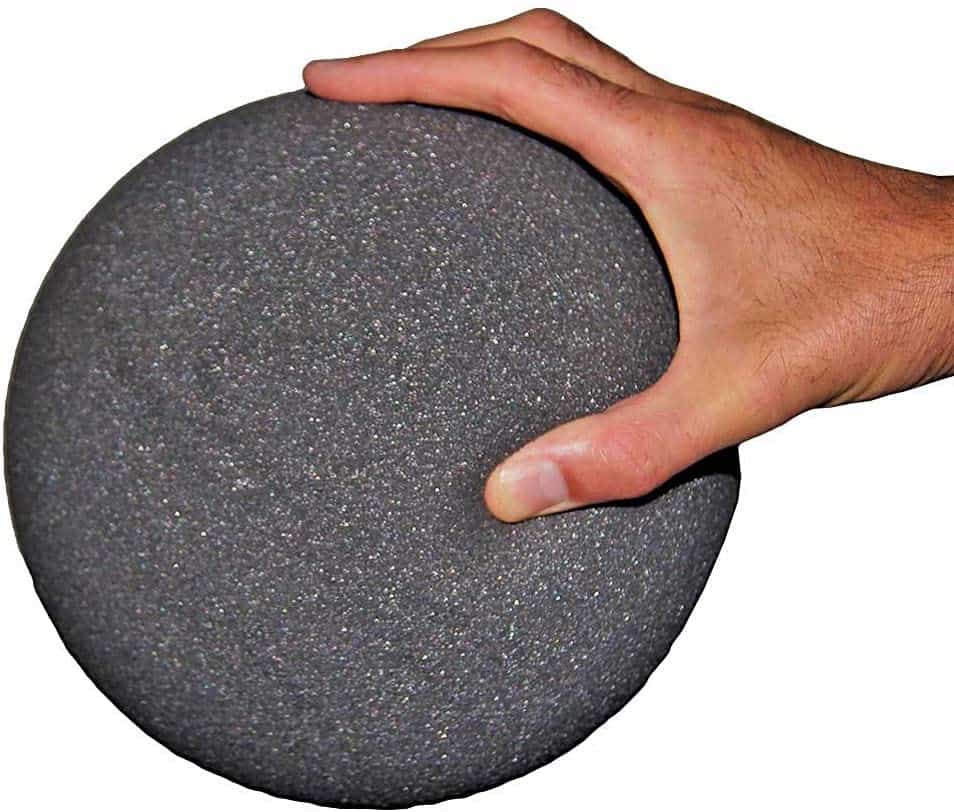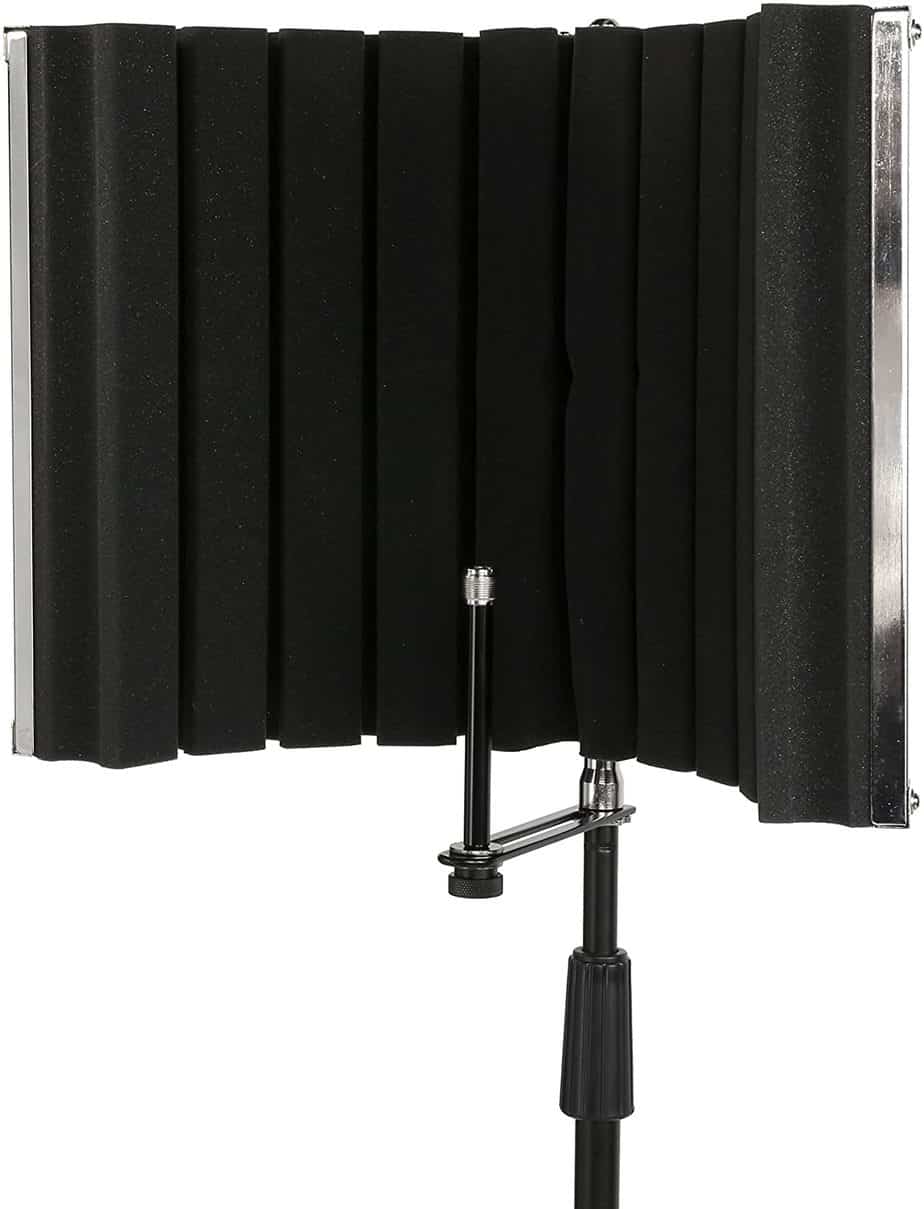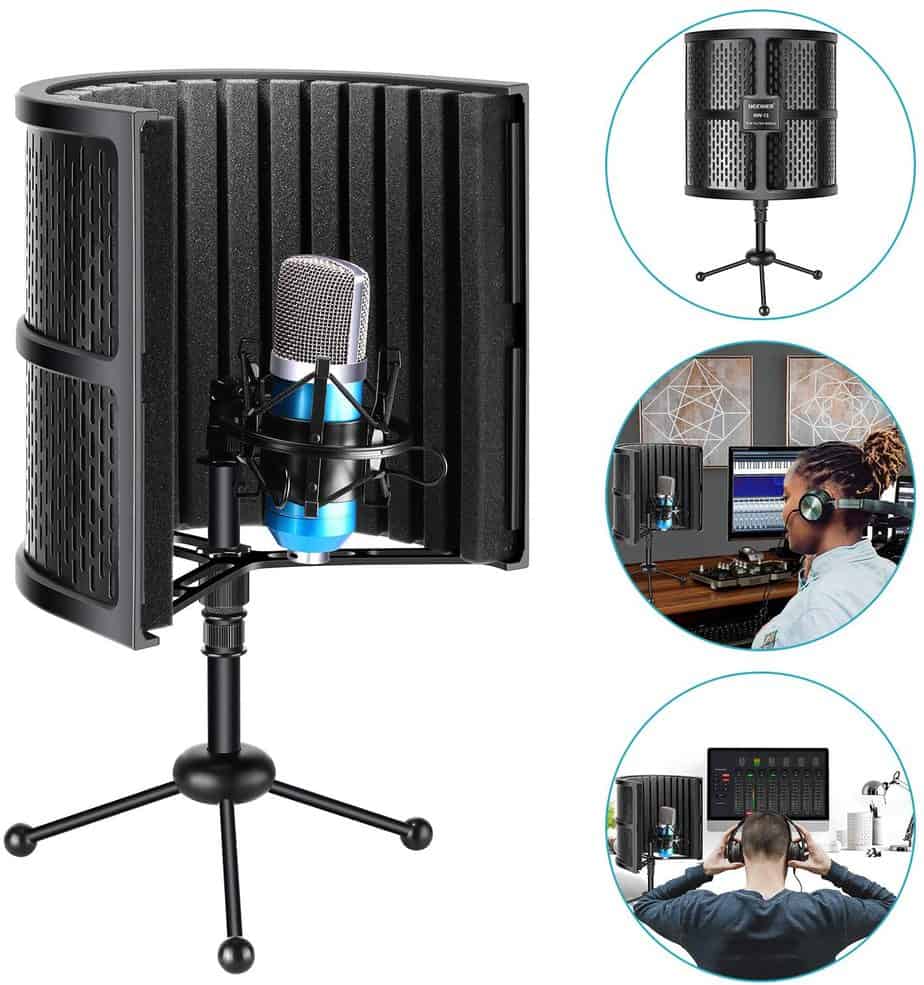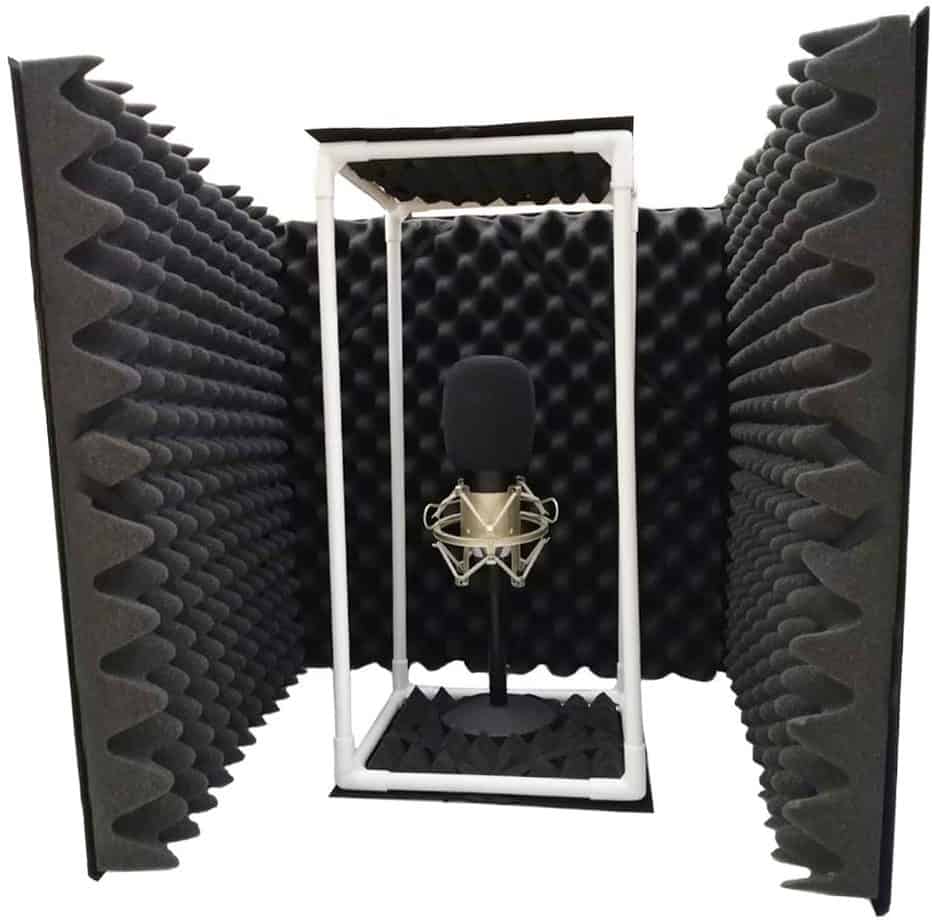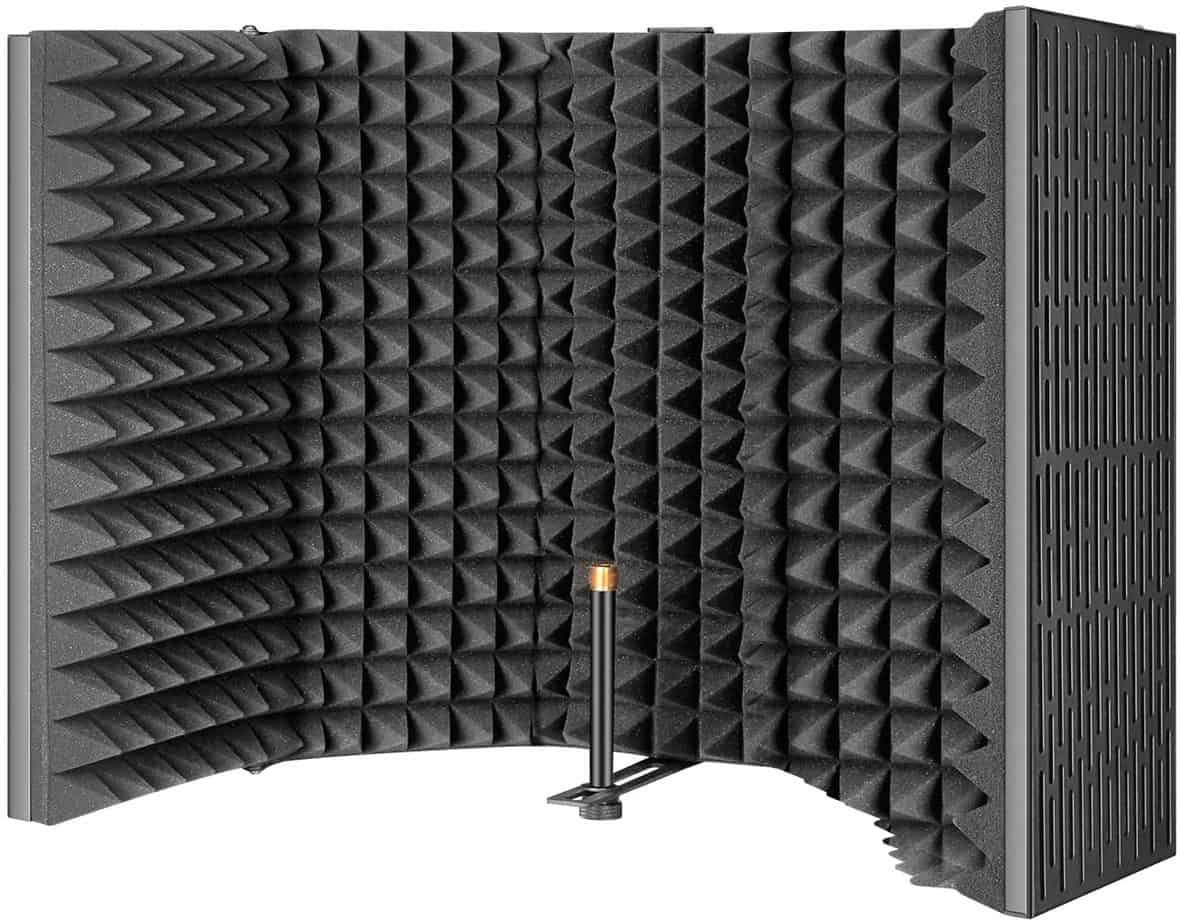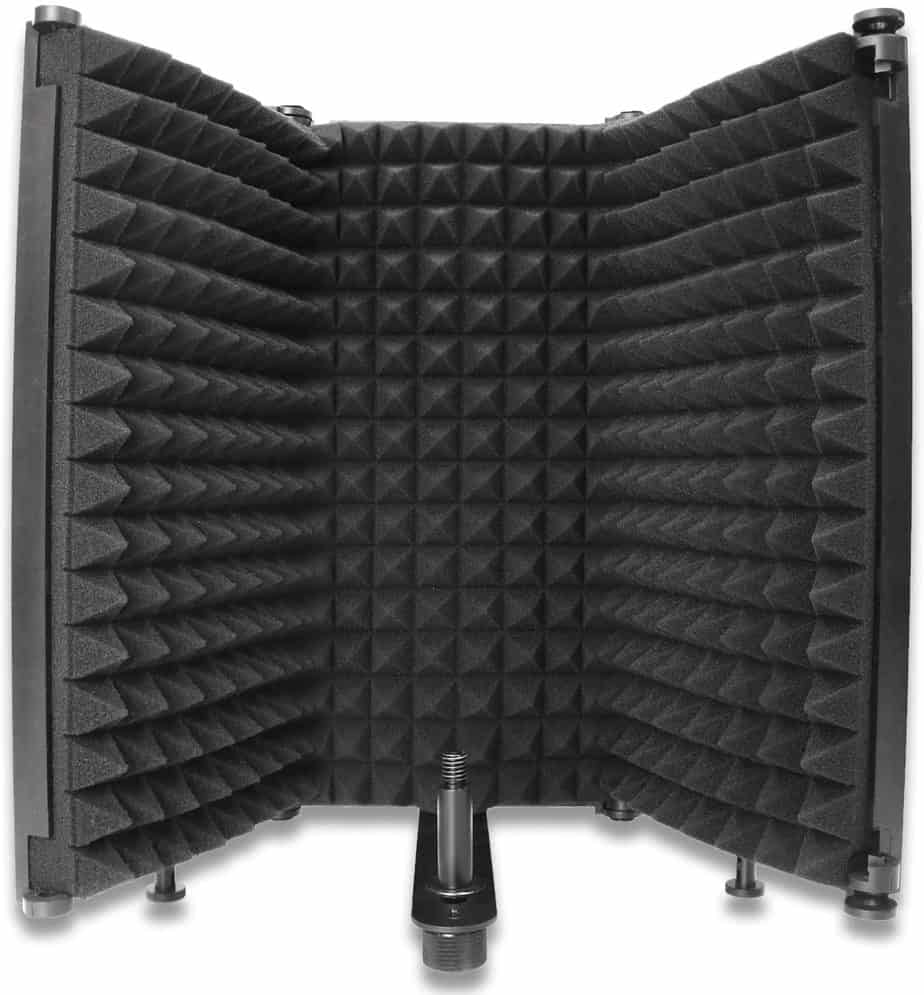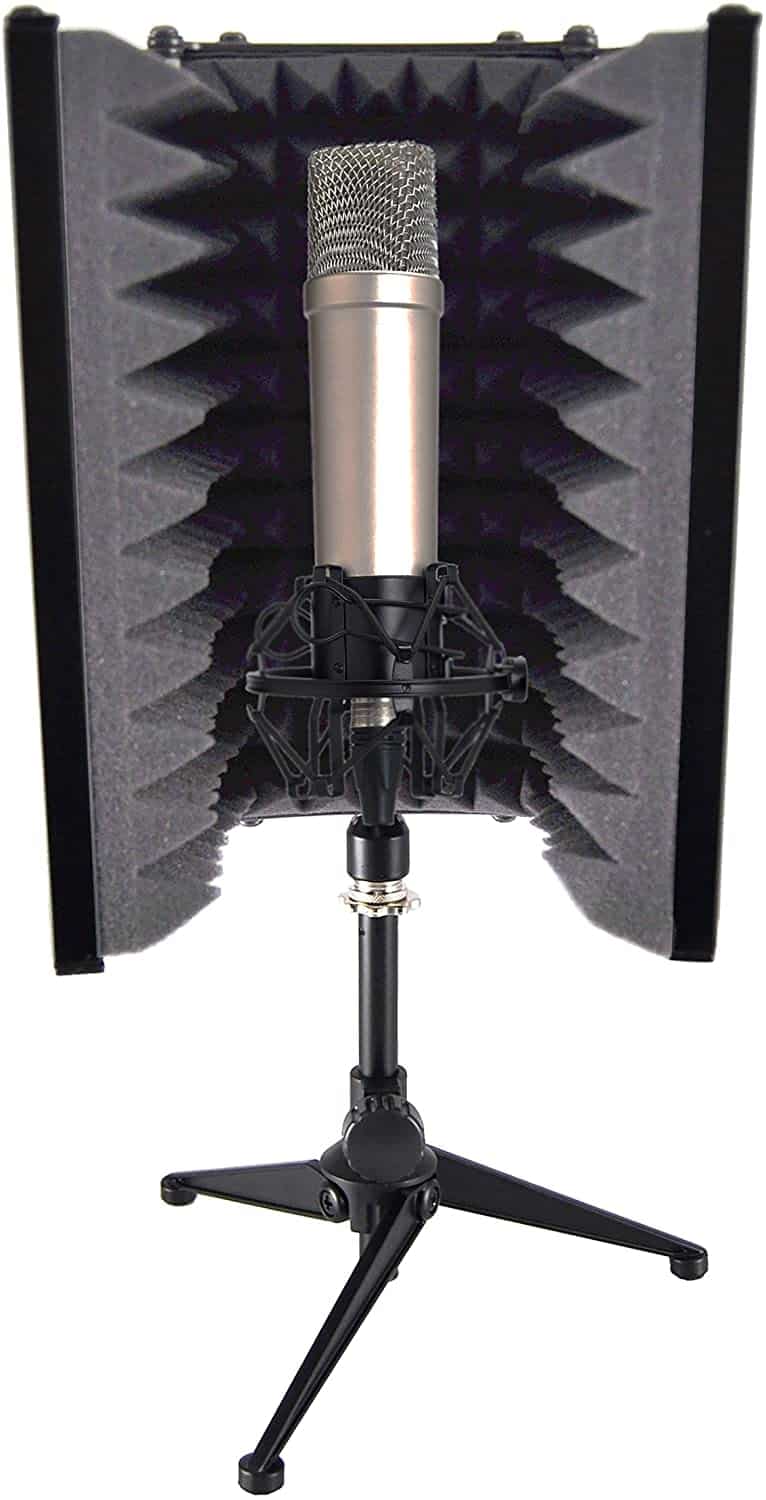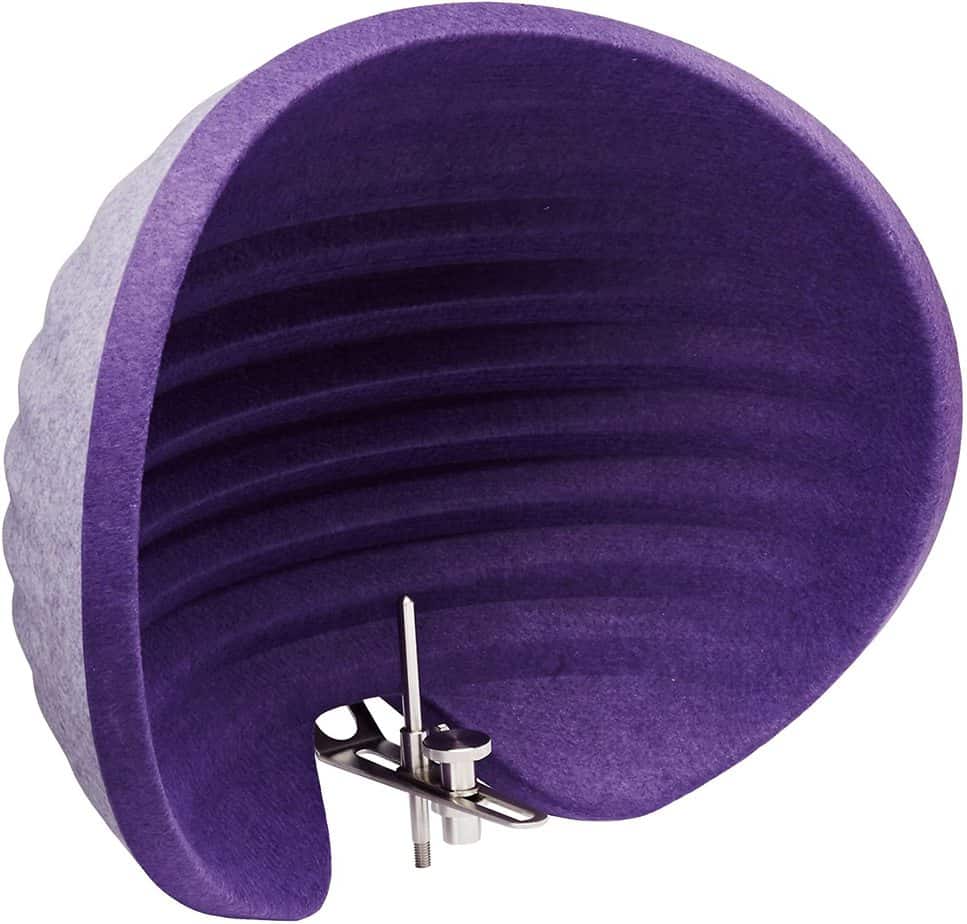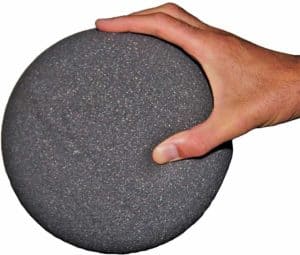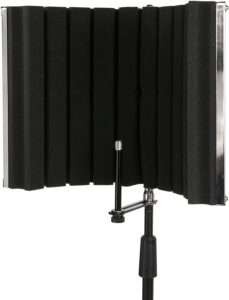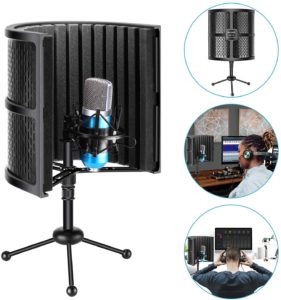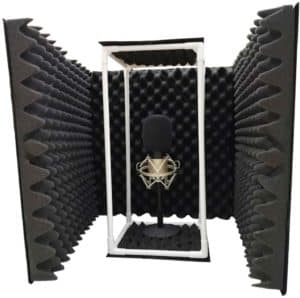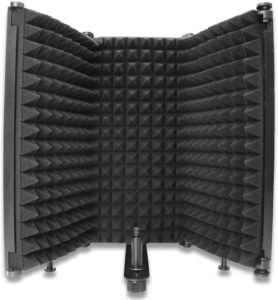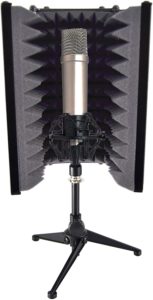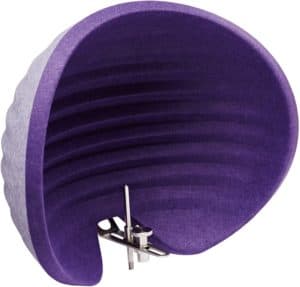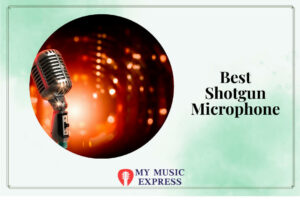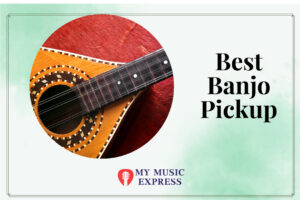The Kaotica eyeball is like a portable recording studio. It is made from high-quality foam, and its premium porous material makes it an ideal sound absorption tool. A Kaotica eyeball is the best alternative to a vocal booth. It will isolate all the sound in your room or garage, and you don’t have to worry about bad acoustics. This product is very efficient and is rapidly gaining attention as the best portable vocal booth in the market.
You will see a great deal of difference in your recordings if you use a Kaotica eyeball. Nowadays, making videos and recording the voice with the help of a microphone has become easier to do at home. Many artists started their careers by recording videos, songs, podcasts, etc. in their homes. Some people record at home because it can be done without spending too much money. But it is a real buzz kill when there are bad acoustics in the room!
This is the main issue that people face when recording at home. The perfect solution for this problem is a Kaotica eyeball. There is a lot of science that goes behind developing a Kaotica eyeball, and it is not just a piece of foam. It is effective, and it will give your recordings a studio-like quality. It will reduce the unwanted reverberations in the room and reduce the sound reflection. It is a budget-friendly option to record music without having to treat the room to better acoustics!
Kaotica Eyeball – Buying Guide
Kaotica eyeball can also double as protection for your mic while traveling. The thick foam keeps the mic and other recording equipment padded. As useful as a Kaotica eyeball can be, there are some things to consider before buying it.
Factors to consider about Kaotica eyeball
There are many Kaotica eyeball alternatives available that will give you the same results, but a quality check is important. The factors to look for before buying a Kaotica eyeball are:
- Noise isolation– The main purpose of a Kaotica eyeball is to reduce unwanted interruptions in the recording environment. If you record in a home studio and it is untreated then you need a sound filter that can effectively cancel the background chatter and minimize the reverbs. Making a room soundproof can be really expensive, so a Kaotica eyeball is an elegant solution to that problem.
- Mic compatibility– The Kaotica eyeball has two holes for inserting the mic and fixing it on the mic stand. Some mics are too big to fit in the eyeball. The Kaotica eyeball alternatives come with hardware to attach the mic. So make sure to check if your mic is compatible with the hardware. The product should come with the necessary hardware to assemble the mic stand. The installation of these products is usually very easy!
- Construction– The construction of the eyeball is what matters the most. If it is poorly made then it will not be able to filter the sound properly. The Kaotica eyeball review says that it is made from high-density foam and its particle size is large. The dense structure absorbs more sound waves, hence giving you more clear and crisp recordings. The thick foam surrounds the mic completely so it also absorbs the sound reflecting from the walls, the ceiling, and the ground.
Kaotica Eyeball Reviews
The Kaotica eyeball is a game-changing product that has made recording at home a lot easier than it was before. It is the ultimate solution for isolating the sound of your microphone. It is considered to be the number 1 portable vocal booth in the market. Many big names in Hollywood like Snoop Dog record only with Kaotica eyeballs. It is a patented design that encapsulates the microphone for isolation.
This way the sound waves move only in one direction through the pop filter, reducing the noise from external factors. It amplifies the sound waves and channels them into the microphone diaphragm. The waves that are not consumed are absorbed by the eyeball, creating an ideal acoustic resonance. It reduces the need to soundproof your room because this eyeball does the same job. It is an easier way to capture high-quality sound and make your music sound better!
There are no color substitutions available, but you can change the pop filter colors by purchasing them separately. It is easy to set up and fits most of microphones. There is no hardware needed to set it up, and it is extremely lightweight. The foam that covers the mic is dense and absorbs all the unwanted sound waves that rebound after hitting the surfaces in the room. A Kaotica eyeball can make a good mic sound great!
Kaotica Eyeball Alternatives
There are many Kaotica eyeball alternatives available in the market that you can use instead of a Kaotica eyeball. Those alternatives are cost-effective and work just the same. Let us review some of the products that you can buy to reduce the reverberations in your home studio and get quality recordings:
This thickly padded foam ball is often used to make a DIY mic isolator. It is used to make a Kaotica eyeball clone. The diameter of this ball is eight inches. It is made from solid foam that absorbs all the sound and prevents reflection. This foam ball is typically made for sports like volleyball and basketball. But it is mostly sold and used as a mic isolator. There is solid foam throughout the body with no skin coating.
It is a high-density foam ball, which is ideal for sound isolation. And it is grey, so the dirt never shows. As it is a solid foam ball, you will have to cut out a hole in which you can fit your microphone. Cut out another hole at 90 degrees from the bigger hole for the connecting stand. Be careful when cutting out the holes and make sure it is even on all sides.
- It completely isolates the sound and provides quiet recordings with no sound reflections.
- It is sturdy, resilient, and does not show any dirt.
- You can easily cut a hole into it and shape it to detailed specs.
- It looks decent, and it will only take you 15-20 minutes to set it up.
- It blocks all the ambient sound for your microphone.
- It has just the right size and density to be a great Kaotica ball alternative.
It may seem a bit unconventional as it is intended to be a sports ball. But when people used it as a DIY eyeball, it exceeded their expectations and gave very good results, much like the real Kaotica eyeball. People have raved about this product in the comment section, saying how wonderfully it worked for them! There will be no need for extensive or intensive room treatments.
It is a microphone isolation shield panel that can be used in the home office and studio. Maintain the clarity of your sound by using this sound isolation shield. The high-quality EVA foam absorbs the sound waves and prevents them from bouncing back. This eliminates any interference in your recordings and delivers utterly clear and crisp sound. The high-density foam reduces noise and audience chatter, which creates an ideal space for recording in a home studio.
It is designed by acoustic experts to preserve the clarity of the sound. The foam layer is of high density. The perforated aluminum frame is sturdy, and you can freely position it anywhere in your recording space. It creates a perfect microphone booth and offers the essential environment for a professional recording. The high-quality construction delivers sound diffusion so that there is no distortion due to the surrounding sound waves.
- The high-end aluminum and foam panels come fully assembled for an effortless setup.
- It comes with all standard mounting hardware and setup accessories.
- It weighs only 3.75 pounds, and the panels can be folded for ease of traveling.
- It includes microphone mounting hardware, which can fit on most mic stands.
- It has an adjustable support bar and comes with a one-year warranty.
- It has a sleek and compact design that offers 100% satisfaction.
It comes with easy-to-follow instructions that make the assembly easy. You only need to unfold the hinged sections, tighten the locks, and then position the mic according to you. It also easily disassembles. You only need to unhinge the parts and pack them in your suitcase. It will work with any mic with the right adaptors. This portable vocal booth is a great investment, and you should go for it!
It is a tabletop shield that is compact. This sound-absorbing shield is made for recording songs, podcasts, vocals, broadcasting, etc. It effectively diffuses the surrounding sound waves from bouncing back from the walls. The thick foam absorbs sound waves and minimizes the reflection. The outer shell is made from ABS plastic material, which makes it lightweight.
The foam is 1.9 inches thick, which effortlessly prevents the penetration of sound waves. The whole set is anti-reverberation and anti-reflection. If you want a little more height added to the isolation shield then connect the mini tripod at the base. It is small in size and stays firmly attached to the surface. The foam panel is curved and covers the mic from all directions nicely. The compact size is great for fitting in small desk spaces.
- It is lightweight and small in size, which makes it easy to carry while traveling.
- It is made from high-density noise-absorbing acoustic foam that is covered with ABS plastic.
- The package contains a pop filter isolation shield, a small tripod, an extension tube, and an adaptor.
- The mini tripod is tough, and its ball legs prevent it from skidding or scratching the tabletop.
- It decreases echoes and negative feedback.
- The panel wards off sound reflection and giver your recordings clarity.
The stand holds the mic well and will keep your sound crystal clear. It is easy to install and can be assembled in 4 easy steps. The height of the panel with the tripod is 15.74 inches. The height of only the panel is 7.08 inches. It is a durable product, and you can benefit from it for years to come. Get studio-like recordings in the comfort of your room!
This is a slightly larger isolation shield that cancels reverberations. Its height is 20 inches, and its width is also 20 inches after setup. There are three panels, like a square with one side missing. The edges are flexible, and you can adjust the panels to increase the space they cover. Remember that the foam comes compressed and you need to decompress it before use.
For decompressing them, you need to soak all the foam panels in warm water for a minute. Press them down to let out all the air bubbles. Then leave them to dry, and they will be completely decompressed. They are big so they are not easily portable, but they are foldable for ease of storage. They are 20 inches long and 23 inches wide after folding. You can use it for recording vocals, podcasting, voice-over, instruments, percussions, etc.
- All the panels have thick and dense acoustic foam, which provides great sound absorption.
- The large protection area can also accommodate electronic devices like laptops or important documents.
- It also includes a box-like stand with top and bottom foam panels for the mic setup.
- It is perfect for desk use and works with all desktop mics.
- It provides great acoustics and removes echoes and reverbs.
- It is easy to set up and gives satisfactory results.
It boosts sound clarity and protects the recordings from room coloration. It prevents the recordings from sounding dry and rather, gives them a rich quality. It will give your acoustics a professional quality and cancel out all the unwanted noise. It specializes in soundproofing your recording space and keeps unwanted ambiance interference at bay. It is very lightweight and spacious so you can keep your essentials inside the panels. It is easy to set up and break down.
This shield has high-density foam that is extra absorbent and is used to filter your vocals. It can be used for professional as well as personal use. You can set it up in your studio or use it at home. It reduces the need for soundproofing your room because you can use the shield to isolate the sound waves. You can use it while recording, dubbing, singing, broadcasting stations, etc.
It has thick foam in front and a porous metal back to let the sound waves pass. The waves that bounce back from the walls get absorbed by the foam and the ones that are not absorbed travel back in the same direction. This happens until the sound waves are too weak to bounce back. The unwanted interference is completely eliminated this way, and you get a clear sound during recording.
- It is suitable for an eyeball mic, a blue Yeti, a blue Snowball iCE, and any condenser microphone.
- Its height is 15 inches, and its width is 25.2 inches, which is large for recording vocals as well as instruments.
- You can use it in a normal upright position, or it can be in an inverted orientation.
- It includes accessories like a connecting rod, a washer, an adaptor, and nuts.
- The two nuts are for fixing the shield to the floor, or you can place it directly on the counter.
- It reduces noise, is anti-reflection, and is foldable.
The outer shell of the sound isolation shield is made from solid metal alloy, and the front is made from professional sound-absorbing foam. There are five panels in this shield, and the two outer panels can be folded for easy storage and portability. The arc of the shield prevents the sound waves from going into the mic. It also has a built-in thread for placing on a mic stand. It has a 2-year warranty.
This is a portable sound shield with absorbing foam to keep the noise away. It has mic reflection filters to filter your vocals. The acoustic foam helps to diffuse the sound and cancel the noise. This way the vocals are recorded and not the noise. The isolation shield has three foam panels that are connected on hinges. You can fold the outer panels to make them compact and easily store them. It can convert any space into a professional studio.
This portable vocal booth will improve room isolation and sound absorption. The shield has feet at the bottom to set it up on a table. The round feet mount the shield firmly on a desk and prevent it from moving or scratching the surface. The acoustic reflection filter is made from high-density foam to give you clear-sounding recordings. The outer shell and the foam padding defend against reverberations and echoes.
- The package includes one microphone isolation shield and one adaptor compatible with a 3/8-inch and 5/8-inch stand screw.
- The panels can be folded inward for a closer and tighter acoustic isolation chamber.
- The isolation shield is easy to set up and foldable for ease of traveling.
- You can either fix it on a tabletop or directly attach the shield to a mic stand.
- The shield is lightweight.
- It is compatible with blue yeti, blue yeti X, AT2020, and any condenser mic.
If you have a home studio but do not have enough protection against bad acoustics then a sound-isolation shield is a necessity for you. It will provide much clearer and better-sounding recordings. You will also save a lot of time in post-production and editing.
This foldable sound isolation sound features dense foam that dampens unwanted sound and blocks them from your recordings. It creates an acoustic boundary around the mic and channels your voice into the mic. This results in an improved vocal flow. The premium acoustic foam blocks the outside noise from air conditioners, fans, televisions, etc. It reduces sound reflections and echoes and removes unwanted chatter from the environment.
It has three foam panels that shield the mic from disturbance and interference. It clears a path for your voice only. It helps to achieve a clear and crisp sound like a studio recording. It is perfect for singing, vocals, podcasting, etc. The angle of the panels can be adjusted, and you can bring them closer to the mic for a more focused and tighter recording.
The panels fold so you can easily transport them. It is compatible with many microphones like the blue snowball mics, AT2035, blue yeti, etc. You can record like a professional with the help of this soundproof filter. The high-density foam is 1.5 inches thick.
- It has a portable and compact design that is quick and easy to set up.
- The sturdy and height-adjustable tripod base provides stability on a desktop or tabletop.
- It features three soundproof studio foam wedgie acoustic tiles.
- The noise isolation shell panel has a rugged and heavy-duty construction.
- You can adjust the angle and height of the sound absorption panels.
- It features a universal standard 5/8-inch microphone threading.
You can screw your mic shock mount to this unit. It also has a spot to screw the mic on. It takes up very little space and gives great results. You can easily attach a pop filter to the stand. It is a simple solution to deal with the bad acoustics in an untreated room. Even if you are using a sensitive condenser mic, it will cut back most of the interference in the recording environment.
The halo reflection filter is much bigger than most of the filters in the market. This is good because it catches more of the source audio. The surface area is at least 40% bigger than the competitor brands. It is extremely lightweight despite its large size. It offers drastically improved sound isolation. It comes with a three-year free replacement warranty. The PET felt is lightweight and is one of the most efficient technical acoustic tools available.
There is so much science that goes into the design and production of the halo. Along with being technically superior, it is also environment-friendly. They pay special attention to making the production green and eco-friendly. Their mic packaging is 100% recyclable, and it is made with 84% recycled materials. Many filters have complicated hardware, which leads to instability.
- It features a hi-tech construction with a patented PET felt that offers enhanced performance.
- It filters the reflections from the top and bottom, not just horizontally.
- It has ribs in the front and the back to diffuse the sound waves and weaken them.
- It is made from 70% recycled PET plastic bottles for sustainable production.
- It comes with proprietary easy-mount hardware, which makes it easy to set up.
- The 360o filtering and a rear depth of 100mm improve room isolation and absorption.
The halo filter is very easy and quick to set up. It is very stable on mic stands, and it looks amazing! It is available in two colors, purple and black. It is built in a way to diffuse the sound waves. Halo outperforms all the other sound filters by a country mile!
Frequently asked questions
-
Does the Kaotica eyeball work?
The Kaotica eyeball is designed to isolate your mic from the external environment and capture the full spectrum of your voice. So it doesn’t matter where you record, your voice will sound consistent. It is supposed to eliminate the reverberations completely.
Many people have used it in their home studios and seen a difference. It does reduce the reverbs and echoes. The sound is clearer than before, and you do not need to soundproof your home studio to record. It works, but the Kaotica eyeball review also says that you will not achieve studio-quality sound. It has thick and dense foam that minimizes the reflections. -
Is Kaotica eyeball worth it?
They say that the Kaotica eyeball channels your vocals into the microphone and keeps the unwanted noise away. If you use it in an untreated room then you will see the difference in the acoustics. With the right level of EQ, the eyeball can sound good.
But there are many Kaotica eyeball alternatives available at much less cost that will do the same thing and give the same results. So, if you are looking for a cost-effective option then Kaotica eyeball is not worth it. It does combat reverbs but not as much as you would like. A foam ball will do the same thing! -
What is the Kaotica eyeball made of?
The Kaotica eyeball is made from premium foam. Its porous structure is ideal for sound absorption. The cell structure is larger thanother replicas of it, and the foam density is high. It has a dense structure. It is like a hollowed-out foam ball, which is how most of the eyeball replicas and knock-offs are made.
But the foam structure is the best in the original Kaotica eyeball and is very effective in absorbing the reverbs. The variables of sound tinges in the recording space are considerably reduced. -
Are reflection filters worth it?
Reflection filters and vocal booths are both Kaotica eyeball alternatives. When you are recording in a home studio where the acoustics are not ideal, then using a reflection filter makes sense. They can be easily set up behind your mic, and they do not take up a lot of space. When the conditions in a studio are not good, and you hear a lot of reverbs in the recording then it is best to invest in a reflection filter or a sound booth.
-
How do you soundproof a room?
You can soundproof a room without spending a lot of money. Any soft and padded material will cover the room and absorb sound waves. They will prevent the waves from bouncing back. So all you need to do is cover the walls with thick blankets and quilts. You can cover the windows with cardboard and curtains. Keep the fan and A.C off when recording.

Hi, I am William. I am a music enthusiast. I play the guitar and ukulele. I like to try out all instruments and review them, to help others make an informed decision. You must choose the right instrument to get that sweet sound you desire. When I am not on my instruments I will be found reading or cooking.

